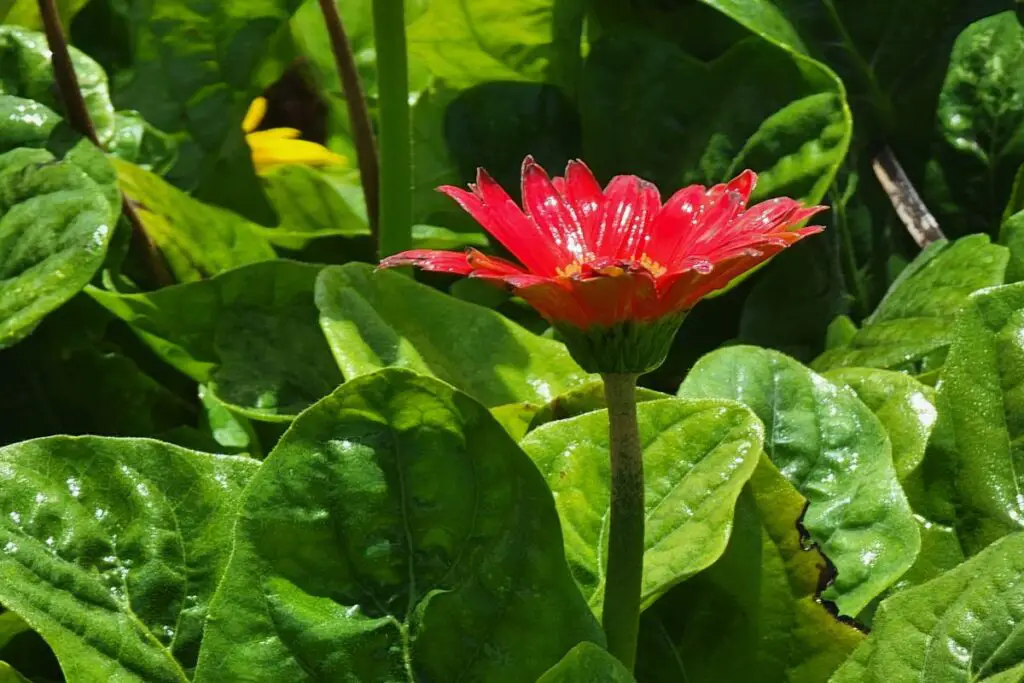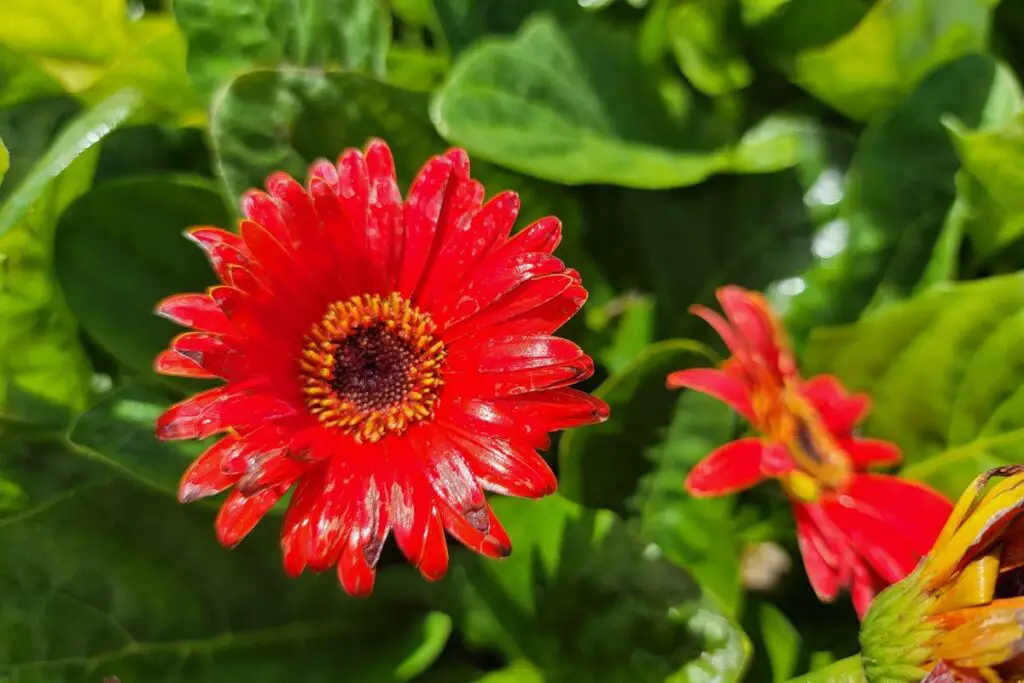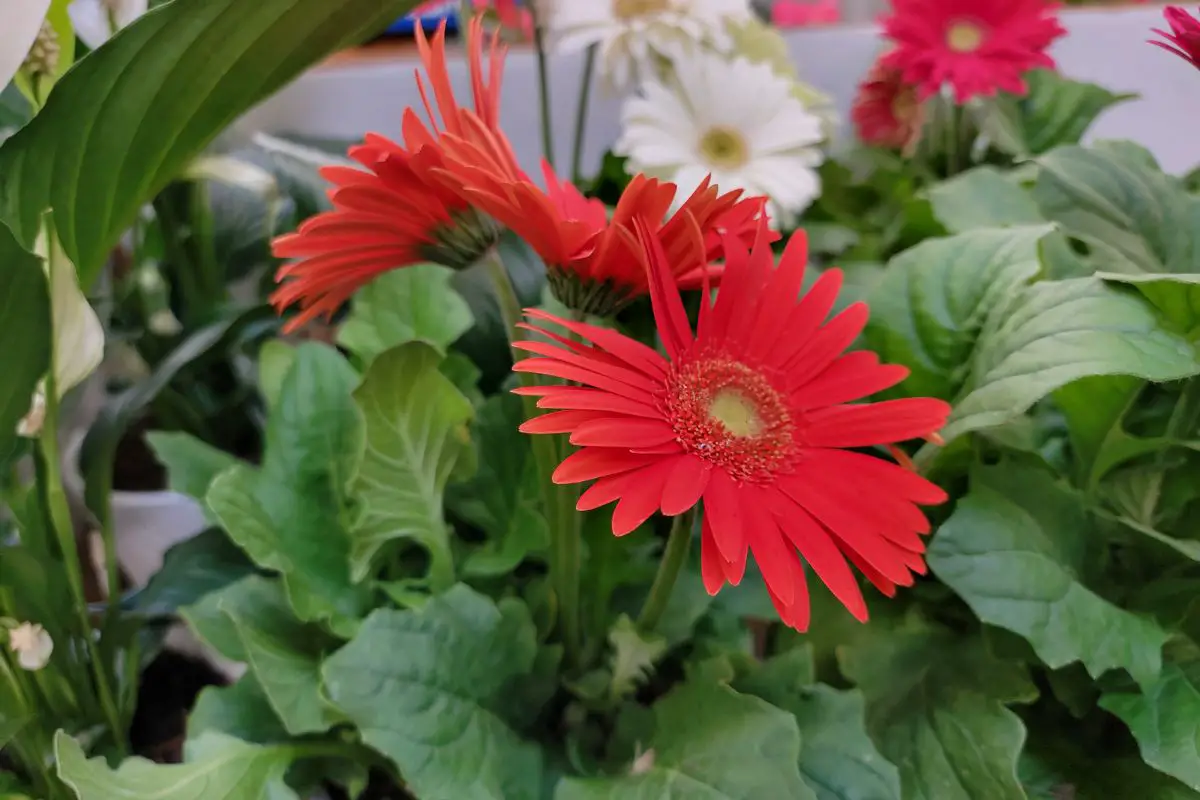Ah, the delightful gerbera daisy – a true passion of mine. What sets them apart is their ability to thrive with just the right balance. While they revel in full sun, a touch of afternoon shade keeps them at their best.
Remarkably, these beauties are low-maintenance, preferring a slightly drier environment. As a seasoned grower, I find nurturing gerbera daisies to be a rewarding and effortless experience.
Gerbera Daisies Care
Gerbera daisies should have the most optimal soil and light conditions for proper growth. Bright sunlight in the morning and protection against afternoon light is best. When planting outdoors, the soil should be eight to ten inches deep and in a spot with morning sun and afternoon shade. Placing them too close to a window indoors could scorch the leaves, so make sure they stay out of direct sunlight.
Gerbera daisies (Gerbera jamesonii) are available in a variety of colors that, include purple, lilac, pink, yellow, orange, red, white, and bicolor. They range in diameter from seven to 12 cm (about 4.72 in). These flowers originated in South Africa but can be grown just about anywhere!
The bright colors and alluring fragrances attract butterflies and bees. They can survive two weeks in a vase. Put them in a lovely vase to add aesthetic beauty to a room.
Supporting Articles
| How to Keep Gerbera Daisies Blooming |
| Gerbera Daisies in Pots |
| Deadheading Gerbera Daisies |
| Gerbera Daisy Sun or Shade |
| Gerbera Daisy Annual or Perennial |
| Gerbera Daisy Colors |
What Do Gerbera Daisies Need to Grow?
The five needs of Gerbera Daisies are:
- Light
- Soil
- Water
- Temperature and Humidity
- Fertilizer
Gerbera Daisies thrive in full sun but not intense heat. In hot summer climates, plant the flowers where they will receive afternoon shade. The soil should be well-draining soil that is rich in organic matter.
The pH level should be between 5.5 and 6.5. A pH above 6.5 may induce chlorosis and yellow stripes on the leaves. When the pH level is too low, leaves may develop black patches or spots.
Gerbera Daisies must be watered regularly, approximately one inch per week. Only water when the soil if one to two inches below the surface is dry. Plants in overly wet soil may become infected with root rot, powdery mildew, or fungal disease.
The flowers require more frequent watering at first and during dry, hot spells, they need some extra H20. The USDA hardiness zones 8 through 11 provide the best temperature. The zones include Connecticut, Delaware, the District of Columbia, and Florida.
A cool, not cold, temperature that ranges from 45 to 50 degrees is ideal. In areas with no winter protection, like Connecticut, Gerbera Daisies are grown in pots as annuals. The amount of fertilizer depends on the quality of the soil.
A monthly application of water-soluble fertilizer is suggested. The amount to use is found on the label instructions.
Although gerberas are perennial flowers, many people grow them as annuals! Learn more: Gerbera Daisies Annuals or Perennials
When to Plant Gerbera Daisies
In most of the U.S., Gerberas are tender perennials. The plants are treated as annuals if there is no winter protection in cold zones. It is best to plant them in the spring when the possibility of frost has passed.
For a good start to a Gerbera bed, choose loam that contains organic matter and drains well. Plants become established, with flowers blossoming in 14 to 18 weeks (about four months). The plants continue to bloom all summer.
Despite being very popular in the U.S., gerbera daisies were not grown in North America, until around 1920!
How to Plant Gerbera Daisies From Seeds
- Plant them indoors 12 to 18 weeks before the last frost to ensure blossoms in the summer.
- Use potting soil and press the seeds lightly into well-draining soil.
- Do not bury them because they need light to sprout.
Adding a propagation medium, such as peat, perlite, coconut coir, or coarse river sand, will hasten the process. After seeds germinate, move them outside in the early spring. Plant them in paper cups or peat, directly in the ground to keep from disturbing the roots.
The crown on the plant is slightly elevated above the soil level. It is the area where the roots and stem meet. When planting starts in the ground, cover the area around them with mulch to suppress weed growth.
Propagation mediums can also be added to soil outdoors if it does not drain well. Space sprouted plants 12 to 18 inches apart.¹

Where Do Gerbera Daisies Grow?
The Gerbera Daisy grows between six and 18 inches tall. That height makes them an excellent option for the front or middle of a flowerbed. Planting the flowers in containers rather than garden beds is best if the soil contains clay.
Plant Gerberas in raised garden beds or containers if the soil is soggy or heavy. Gerbera Daisies in pots are easier to move indoors during the winter. A container with loose standard potting soil works well if the crown stays slightly above the surface.
If planting in the ground, choose a sunny site with acidic and well-draining soil, and a little bit of shade in the afternoon. Mix a little compost into the soil.
How to Care for Gerbera Daisies
Gerbera Daisies flourish when proper growth conditions are met. Pair Gerberas with yellow foliage plants like short grasses to enhance their bold colors. Lobelia and Sage have spikey or tiny blue blossoms that bring out the sunset tones of Gerberas.
Remove wasted flowers to keep the plants blossoming. If a plant becomes too bushy, prune some leaves clumped together at the center to make room for more light. Do not plant flowers close to a stone wall of foundation that reflects heat. The reflected heat is harmful to the growth of the plants.
When the flowers are fully opened, and the centers remain tight, they can be harvested. Place them in one inch of water and add more as necessary. Too much water shortens the display time.
Remedy a discolored stem by making a fresh angle cut on the stem.
Check out: How to Keep Gerbera Daisies Blooming
How to Trim Gerbera Daisies
Gerbera Daisies are fragile and require daily care. Keeping the flowers pruned helps keep them healthy and encourages a second blooming. Find the leaves by separating the foliage.
Use a sharp knife to cut off the leaves that appear diseased or have begun to wither. Make a cut 1/8-inch from the base. Cut off withered flowers at the base.
When blooms peak, cut them for bouquets and flower arrangements. The stems should be cut at a 45-degree angle and immediately placed in an inch of water to prolong the flower’s life. Cutting flowers to be used in arrangements stimulates more blooming.
Check for mildew when you water the plants. It is a blue or white powdery substance on the leaves or soil. Use a knife to remove any infected leaves immediately.
If the problem persists, apply a fungicide. After the growing season, allow the leaves to wither and die naturally. Cut the dead leaves to the ground.
A pot-grown Gerbera has a solid mass of stems. It is essential to cut out dying or dead stems (this is called deadheading). A heavy concentration of stems promotes the growth of fungi and molds that kill plants.
Remove damaged, dying, or dead stems with a safety razor or sharp knife. Cut as close to the soil as possible. Try to make the angle of the cut such that water falling on it will roll off.
learn more about deadheading here: How to Deadhead Gerbera Daisies
Gerbera Daisy Care: Indoor and Outdoor Growing Tips
Indoor Plants
To care for indoor Gerbera Daisies, start with a container that drains well. The bottom of the container must have at least one hole to avoid powdery mildew, crown rot, or root rot. Having more is better.
The ideal potting mix soil makes caring for the plants easier. Fill the container with approximately three inches of soil using high-quality potting soil. Place the plants in the container and add more soil to where the stem and roots meet, slightly above the ground.
Providing light for a Gerbera Daisy is tricky. Placing the container near a sunny window provides adequate light but may burn the leaves because the temperature is too high. The plants tolerate temperatures less than 70°.
If indirect sunlight is used, ensure the plant receives light all day. Use overhead lighting or place lamps nearby, especially during the winter. Water the plant when the potting soil feels dry.
Soak the roots but try to keep the leaves dry. Do not put the container back on a drip tray or saucer until the pot is thoroughly drained. Boost the growth of the plants with fertilizer for blooming plants.
Fertilize Gerbera Daisies during the growing season only. As blooms fade and wilt, cut off or pinch the flowers next to the stem. If the plant begins to multiply, repot it in a larger container.
Outdoor Plants
For outdoor plants, pick a spot with morning sun and shade in the afternoon. Spade the soil eight to ten inches deep. Add a layer of compost or manure.
There should be 18 to 24 inches of space between plants. The crown of the plant should be just above ground level. Gerbera Daisies can go about a week without being watered.
Water them when the soil and crown are dry. You should water in the morning to allow the leaves to dry and reduce problems with rot and fungal diseases. Using a soaker hose or a light trickle from a regular hose to water deeply is best.
During the growing season, add fertilizer monthly. A fertilizer that contains magnesium or iron is best. Add two to three inches of compost or mulch around the plants in the spring.
Leave space between the crown and the material. Like indoor plants, deadhead wilted blooms. Every two years, dig up the Gerbera Daisies in the fall and replant them in the spring.
Use a garden fork to keep from damaging the roots.
Learn more about light conditions here: Gerbera Daisies Sun or Shade

How Long Does a Gerbera Daisy Last?
Gerbera Daisies are popular flowers both indoors and outdoors. They are not winter hardy in some areas but are well-suited for growing indoors in the winter. Potted Gerberas last about three years, and the blooms last for two or more months.
When provided with the right conditions, they grow indoors and flower on and off all year. Bring outdoor pots indoors before the first frost. They cannot handle freezing temperatures.
For more indoor information check out: Gerbera Daisies in Pots
If Gerbera Daisies are not exposed to freezing temperatures, they will bloom year after year. After a few years, the plants may outgrow the container.
Due to their long taproots, transplanting them is difficult. You may be able to remove offsets from the mother plant and successfully re-pot them. It may be necessary to start with fresh plants purchased from a nursery or grown from seeds.
Conclusion
I’ve been growing gerbera daisies for years and have found that with the right care, they thrive in the garden, both outdoors, and in pots indoors. Their many colors and iconic look, keep them popular, but they remain a classy part of anyone’s arrangement or garden. We hope you have enjoyed this gerbera daisies care guide!
Before you go, check out: Gerbera Daisy Colors
What will you be doing with your gerbera daisies?
Additional Sources
***
¹Gerbera Daisies Growing Handbook: The Complete Guide On How To Care And Grow Your Flower (All You Must Know) by Ethan Theresa

